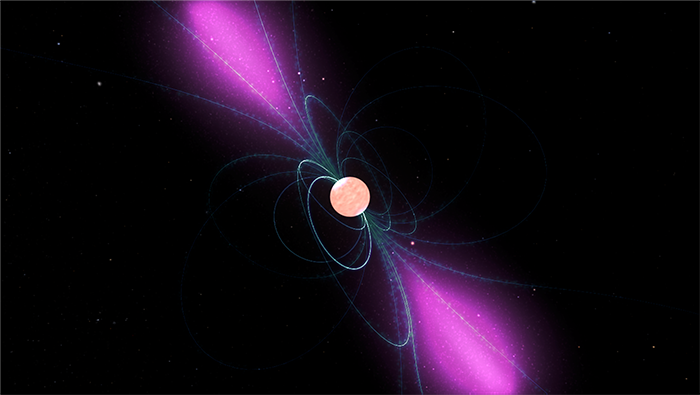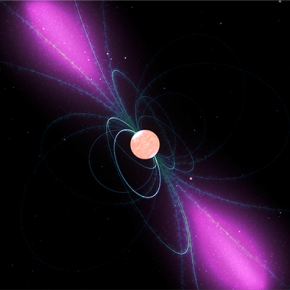
H.E.S.S. collaboration detects the most energetic cosmic-ray electrons and positrons ever observed
|
Scientists from the CNRS, a consortium of German universities, and the Max-Planck-Institut für Kernphysik working at the H.E.S.S. observatory have recently identified electrons and positrons with the highest energies ever recorded on Earth. They provide evidence of cosmic processes emitting colossal amounts of energy, the origins of which are as yet unknown. These findings are due to be published on 25 November in the journal Physical Review Letters.
The Universe teems with extreme environments, ranging from the very coldest temperatures to the highest energy sources possible. As a consequence, extreme objects such as supernova remnants, pulsars and active galactic nuclei are capable of emitting charged particles and gamma rays with incredibly high energies, so high that they exceed the energy produced by the nuclear fusion in stars by several orders of magnitude.
The gamma rays detected on Earth tell us a great deal about these sources, since they travel through space undisturbed. However, in the case of charged particles, also known as cosmic rays, things are more complicated because they are constantly buffeted by the magnetic fields present everywhere in the Universe, and impact the Earth isotropically, in other words from all directions. What's more, these charged particles lose some of their energy along the way, when they interact with light and magnetic fields. These energy losses are especially significant for the most energetic electrons and positrons, known as cosmic-ray electrons (CRe), whose energy exceeds one teraelectronvolt (TeV) (i.e. 1000 billion times greater than that of visible light)1 . It is therefore impossible to determine the point of origin of such charged particles in space, although their detection on Earth is a clear indicator that there are powerful cosmic-ray particle accelerators in its vicinity.
However, detecting electrons and positrons with energies of several teraelectronvolts is particularly challenging. Space-based instruments, with detection areas of around one square metre, are unable to capture sufficient numbers of such particles, which become increasingly rare the higher their energy. Ground-based instruments on the other hand, which indirectly detect the arrival of cosmic rays via the showers of particles they produce in the Earth's atmosphere, are faced with the challenge of differentiating the showers triggered by cosmic-ray electrons (or positrons) from the much more frequent showers produced by the impact of the heavier cosmic-ray protons and nuclei. The H.E.S.S. Observatory2 located in Namibia uses five large telescopes to capture and record the faint Cherenkov radiation produced by the heavily charged particles and photons that enter the Earth's atmosphere, producing a shower of particles in their wake. Although the Observatory’s main purpose is to detect and select gamma rays in order to investigate their sources, the data can also be used to search for cosmic-ray electrons.
In the most extensive analysis ever carried out, H.E.S.S. collaboration scientists have now obtained new information about the origin of these particles. The astrophysicists did this by combing through the huge data set collected over the course of a decade by the four 12-metre telescopes, applying new, more powerful selection algorithms capable of extracting the CRe from the background noise with unprecedented efficiency. This resulted in an unrivalled set of statistical data for the analysis of cosmic-ray electrons. More specifically, the H.E.S.S. researchers were able to obtain for the first time data about CRe in the highest energy ranges, all the way up to 40 TeV. This enabled them to identify a surprisingly sharp break in the energy distribution of the cosmic-ray electrons.
“This is an important result, as we can conclude that the measured CRe most likely originate from very few sources in the vicinity of our own solar system, up to a maximum of a few 1000 light years away, a very small distance compared to the size of our Galaxy”, explains Kathrin Egberts, from the University of Potsdam, one of the corresponding authors of the study.
“We were able to put severe constrains on the origin of these cosmic electrons with our detailed analysis for the first time”, adds Prof. Hofmann from the Max-Planck-Institut für Kernphysik, co-author of the study. “The very low fluxes at larger TeV limit the possibilities of space-based missions to compete with this measurement. Thereby, our measurement does not only provide data in a crucial and previously unexplored energy range, impacting our understanding of the local neighbourhood, but it is also likely to remain a benchmark for the coming years”, Mathieu de Naurois, CNRS Researcher from the Laboratoire Leprince-Ringuet, adds.


- 11 TeV = 10 to the twelve electronvolts.
- 2High-energy gamma rays can be observed from the ground only because of a very specific phenomenon. When a gamma ray enters the atmosphere it collides with its atoms and molecules, producing new particles that sweep towards the ground rather like an avalanche. The particles emit flashes lasting mere billionths of a second (Cherenkov radiation), which can be observed using large, specially equipped ground-based telescopes. The H.E.S.S. Observatory, located in the Khomas Highlands of Namibia at an altitude of 1835 m, officially began operation in 2002. It comprises an array of five telescopes. Four telescopes with mirrors 12 m in diameter are located at the corners of a square, with another 28 m telescope at the centre. This makes it possible to detect cosmic gamma rays ranging from a few tens of gigaelectronvolts (GeV, 10 to the nine electronvolts) to a few tens of teraelectronvolts (TeV, 10 to the twelve electronvolts). By comparison, photons of visible light have an energy of two to three electronvolts. H.E.S.S. is currently the only instrument observing the southern sky in high-energy gamma-ray light. It is also the largest and most sensitive telescope system of its kind.
High-Statistics Measurement of the Cosmic-Ray Electron Spectrum with H.E.S.S.
H.E.S.S. Collaboration. Physical Review Letters, 25 November 2024.
DOI : 10.1103/PhysRevLett.133.221001


